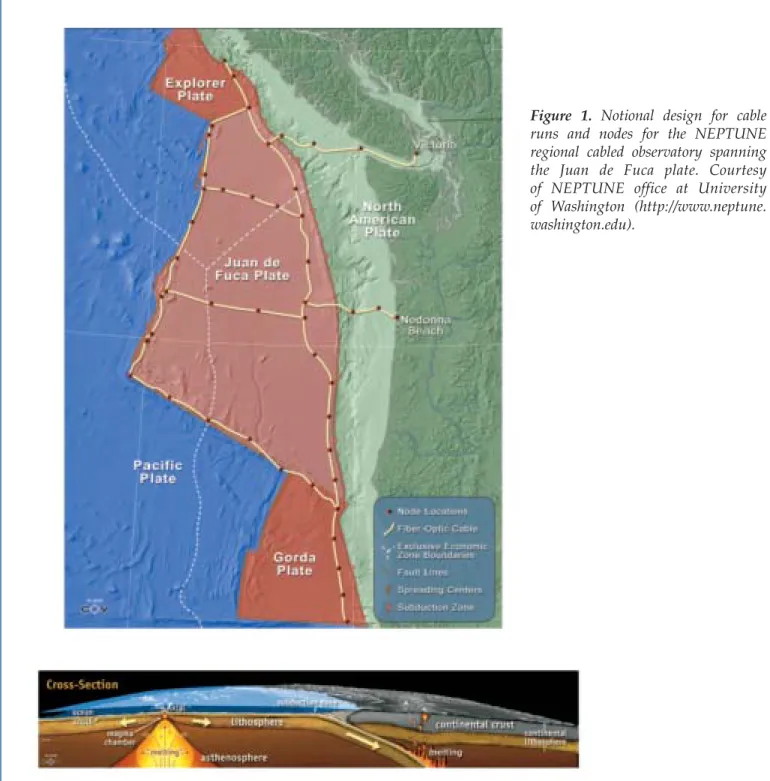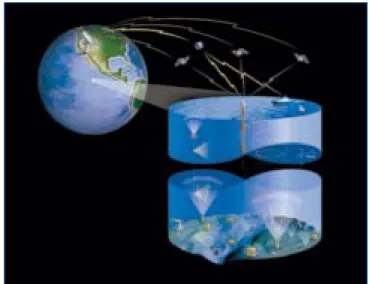to expeditionary investigations for spatial sampling and mapping—can be traced back at least two if not three decades. The evolution is documented in the reports of a number of international and national workshops that date back to the early 1980s, had an initial peak around 1994–1995, have continued fairly regularly since, and perhaps are enjoying a second peak at the current time as implementation plans are developed for the OOI. The rationale developed in workshops through the mid- 1990s led to a 1997–1999 “DEOS” (Dynamics of Earth and Ocean Systems) planning effort supported by NSF that culminated in an independent study on seafloor observatory science by the National Research Council (2000). Rather than summarize the workshop history, we focus below on the development of the scientific ration- ale within marine geology and geophysics for the OOI.
The approach embodied in the OOI is implicit in discus- sions of scientific and technological needs for sustained time-series presence for at least two of the unified “New Directions” outlined in the “Futures” report of the 1996 FUMAGES workshop: “the societal imperative of mak- ing rapid progress in scientific understanding of compli- cated, non-linear systems” and “the appreciation that we must move beyond steady-state models to study geolog- ic events as they happen.” The scientific and infrastruc- tural needs for sustained time-series observations are also highlighted in two subsequent NSF reports, the 2001 NSF “Decadal” report in Ocean Sciences (“Ocean Sciences at the New Millennium”) and the 1999–2003 Facilities Plan for the NSF Geosciences Directorate.
Two “Classes” of Seafloor/Ocean Observatories
The geological and geophysical threads that coa- lesced in the 1997–1999 DEOS planning effort generally defined two “classes” of seafloor observatories:
• “Global” observatories, sited to complete the geometrically-even global coverage necessary to (a) image fully the interior of the Earth and understand whole Earth processes using irregu- lar and unpredictable natural source signals such as earthquakes, as well as (b) to provide a synop- tic view of oceanographic variables on a global spatial scale. With 70% of the Earth’s surface The ocean sciences are based on a rich exploratory
heritage that dates back over a century, and expedi- tionary oceanography on dedicated research vessels will remain a vital component of current ocean sciences research—but a complementary new approach is also being embraced by the ocean sciences community.
Recent decades have witnessed increasingly detailed spatial exploration of the oceans and seafloor, along with an evolution toward temporal exploration of change in the oceans and linkages among active processes through sustained time-series observations and adaptive long-term observatory technology.
Understanding temporal evolution and linkages among processes in the oceans and the underlying plates will require a coordinated investment in a full- time observational presence within the oceans and on and beneath the seafloor—an approach that is embod- ied in the budding Ocean Observatories Initiative (OOI) and Ocean Research Interactive Observatories Network (ORION) program within the National Science Foundation (NSF; Isern and Clark, in press;
Clark, foreword to this volume).
While the value of sustained time series observa- tions is acknowledged throughout all ocean sciences, some of the earliest coordinated efforts toward seafloor observatory science came from marine geology and geophysics, either within formal programs or from small groups of scientists. The purpose of this article is to provide a brief historical perspective of the marine geological and geophysical roots that have joined with comparable roots from other branches of ocean sci- ences (described in other articles in this issue) in the evolutionary process toward ocean and seafloor obser- vatory science. The philosophical approach and invest- ments in infrastructure for sustained time-series obser- vations can be shared across all disciplines of ocean sciences, and ultimately, crossing the lines between dis- ciplines may be one of the greatest benefits of the OOI.
Seafloor Observatories for Geology and Geophysics
Within marine geology and geophysics, the evolu- tion toward a sustained time-series observational approach to understanding processes—as a complement
Keir Becker
Rosenstiel School of Marine and Atmospheric Science, University of Miami
•Miami, Florida USA
Special Issue—Ocean Observations
Marine Geological and Geophysical Roots of the Ocean Observatories Initiative
This article has been published in Oceanography, Volume 16, Number 4, a quarterly journal of The Oceanography Society. Copyright 2003 by The Oceanography Society. All rights reserved.Reproductionof any portion of this article by photocopy machine, reposting, or other means without prior authorization of The Oceanography Society is strictly prohibited. Send all correspondence to: info@tos.org, or5912 LeMay Road, Rockville, MD 20851-2326, USA.

